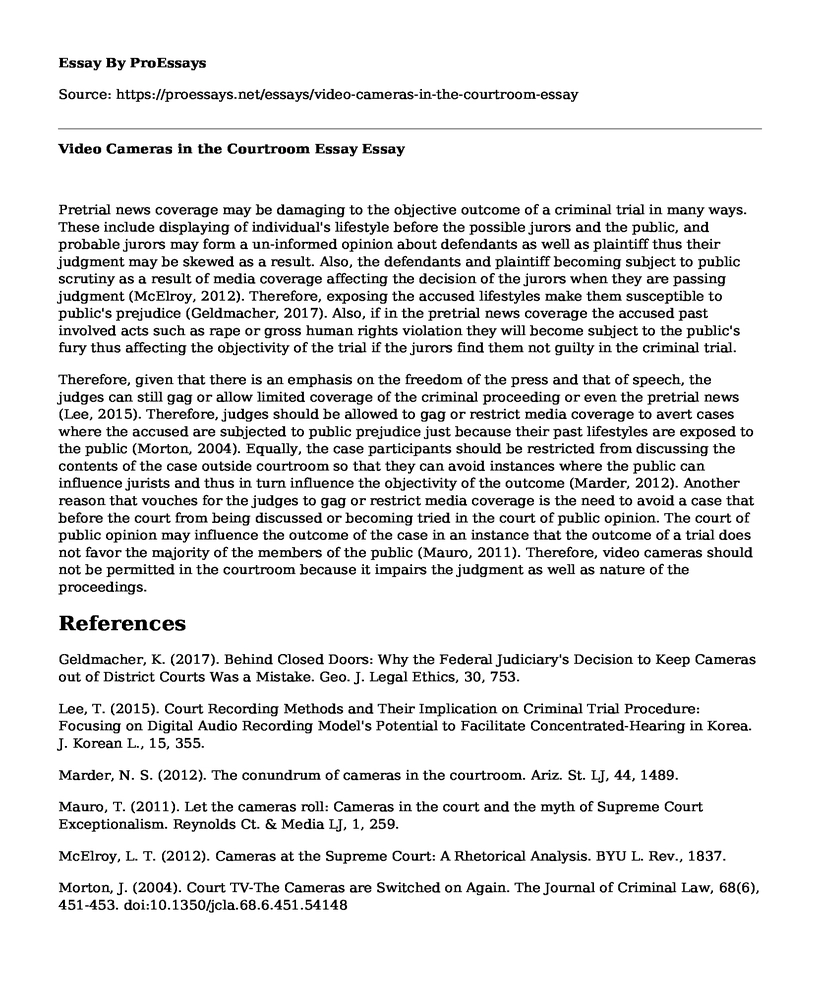Pretrial news coverage may be damaging to the objective outcome of a criminal trial in many ways. These include displaying of individual's lifestyle before the possible jurors and the public, and probable jurors may form a un-informed opinion about defendants as well as plaintiff thus their judgment may be skewed as a result. Also, the defendants and plaintiff becoming subject to public scrutiny as a result of media coverage affecting the decision of the jurors when they are passing judgment (McElroy, 2012). Therefore, exposing the accused lifestyles make them susceptible to public's prejudice (Geldmacher, 2017). Also, if in the pretrial news coverage the accused past involved acts such as rape or gross human rights violation they will become subject to the public's fury thus affecting the objectivity of the trial if the jurors find them not guilty in the criminal trial.
Therefore, given that there is an emphasis on the freedom of the press and that of speech, the judges can still gag or allow limited coverage of the criminal proceeding or even the pretrial news (Lee, 2015). Therefore, judges should be allowed to gag or restrict media coverage to avert cases where the accused are subjected to public prejudice just because their past lifestyles are exposed to the public (Morton, 2004). Equally, the case participants should be restricted from discussing the contents of the case outside courtroom so that they can avoid instances where the public can influence jurists and thus in turn influence the objectivity of the outcome (Marder, 2012). Another reason that vouches for the judges to gag or restrict media coverage is the need to avoid a case that before the court from being discussed or becoming tried in the court of public opinion. The court of public opinion may influence the outcome of the case in an instance that the outcome of a trial does not favor the majority of the members of the public (Mauro, 2011). Therefore, video cameras should not be permitted in the courtroom because it impairs the judgment as well as nature of the proceedings.
References
Geldmacher, K. (2017). Behind Closed Doors: Why the Federal Judiciary's Decision to Keep Cameras out of District Courts Was a Mistake. Geo. J. Legal Ethics, 30, 753.
Lee, T. (2015). Court Recording Methods and Their Implication on Criminal Trial Procedure: Focusing on Digital Audio Recording Model's Potential to Facilitate Concentrated-Hearing in Korea. J. Korean L., 15, 355.
Marder, N. S. (2012). The conundrum of cameras in the courtroom. Ariz. St. LJ, 44, 1489.
Mauro, T. (2011). Let the cameras roll: Cameras in the court and the myth of Supreme Court Exceptionalism. Reynolds Ct. & Media LJ, 1, 259.
McElroy, L. T. (2012). Cameras at the Supreme Court: A Rhetorical Analysis. BYU L. Rev., 1837.
Morton, J. (2004). Court TV-The Cameras are Switched on Again. The Journal of Criminal Law, 68(6), 451-453. doi:10.1350/jcla.68.6.451.54148
Cite this page
Video Cameras in the Courtroom Essay. (2022, May 26). Retrieved from https://proessays.net/essays/video-cameras-in-the-courtroom-essay
If you are the original author of this essay and no longer wish to have it published on the ProEssays website, please click below to request its removal:
- Paper Example on Disruptive Innovation and Education
- Individuals With Disabilities Education Act Paper Example
- Immigration Act of 2016 Essay
- No More Fines: Medicaid Insurance and the Affordable Care Act - Essay Sample
- Exploring Criminology: Classical and Positivist Schools of Thought - Essay Sample
- Prisoners Receiving Free College Education: Pros & Cons - Essay Sample
- Essay Example on Securing Digital Data: Cybersecurity Strategies and Tactics







